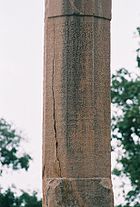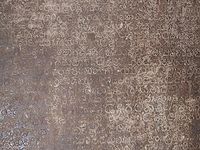
Vikramaditya II
Encyclopedia

Vijayaditya
Vijayaditya followed his father, Vikramaditya I on to the Chalukya throne. His long reign was marked by general peace and prosperity. Vijayaditya also built a number of temples....
and ascended the Badami Chalukya
Chalukya dynasty
The Chalukya dynasty was an Indian royal dynasty that ruled large parts of southern and central India between the 6th and the 12th centuries. During this period, they ruled as three related yet individual dynasties. The earliest dynasty, known as the "Badami Chalukyas", ruled from Vatapi from the...
throne following the death of his father. This information comes from the Lakshmeshwar
Lakshmeshwar
Lakshmeshwara is a town in Shirahatti taluk, Gadag district, North Karnataka, in the Indian state of Karnataka. It is about 50 km from Gadag and 55 km from Hubli. Lakshmeshwara is an agricultural trading town....
inscriptions in Kannada dated January 13 735. From inscriptions it has come to be known that even before his coronation, Vikramaditya II, as a crown prince (Yuvaraja), had conduced successful military campaigns against their arch enemy, the Pallavas of Kanchipuram
Kanchipuram
Kanchipuram, or Kanchi, is a temple city and a municipality in Kanchipuram district in the Indian state of Tamil Nadu. It is a temple town and the headquarters of Kanchipuram district...
. His most important achievements were the capture of Kanchipuram on three occasions, the first time as a crown prince, the second time as an emperor and the third time under the leadership of his son and crown prince Kirtivarman II
Kirtivarman II
Kirtivarman II also known as Rahappa was the last ruler in the Badami Chalukya dynasty. He succeeded his father Vikramaditya II...
. This is attested to by another Kannada inscription, known as the Virupaksha Temple inscription which alludes to the emperor as the conqueror of Kanchi on three occasions and reads Sri Vikramaditya-bhatarar-mume-Kanchiyan-mume parajisidor. The other notable achievement was the consecration of the famous Virupaksha Temple (Lokeshwara temple) and Mallikarjuna Temple (Trilokeshwara temple) by his queens Lokadevi and Trilokadevi at Pattadakal
Pattadakal
Pattadakal is a village in Karnataka. It lies on the banks of the Malaprabha River in Bagalkot district. It is 22 km from Badami and about 10 km from Aihole...
. These two monuments are the centre piece of the UNESCO
UNESCO
The United Nations Educational, Scientific and Cultural Organization is a specialized agency of the United Nations...
World Heritage Monuments at Pattadakal.
Wars against Pallavas



Badami
Badami , formerly known as Vatapi, is a town and headquarters of a taluk by the same name, in the Bagalkot district of Karnataka, India. It was the regal capital of the Badami Chalukyas from 540 to 757 AD. It is famous for rock cut and other structural temples...
, thus bringing to an end the glorious reign of Pulakesi II
Pulakesi II
Pulakesin II is the most famous ruler of the Chalukya dynasty. In his reign the Chalukyas of Badami saw their kingdom extend over most of the Deccan.-Early life and accession:...
and causing humiliation to the Chalukya royal family. From these inscriptions it is known that nothing short of complete annihilation of the Pallavas (prakrity-amitra) could redeem the lost dignity of the Chalukyas. Vikarmaditya II, armed with this vengeful enthusiasm (mahotsaha) invaded the Pallava country.
Immediately after coming to power, Vikramaditya II saw an opportunity in the ensuing civil war in Kanchipuram and espoused the cause of Chitramaya, against that of Nandivarman II. Vikramaditya II fought many battles with the Pallavas and won three important victories and occupied Kanchipuram
Kanchipuram
Kanchipuram, or Kanchi, is a temple city and a municipality in Kanchipuram district in the Indian state of Tamil Nadu. It is a temple town and the headquarters of Kanchipuram district...
on those occasions. Around 730, as the Chalukya crown prince, assisted by the Western Ganga Dynasty prince Ereyappa, he attacked the Pallava Paramesvaravarman II
Paramesvaravarman II
Paramesvaravarman II was a Pallava king who ruled from 728 to 731. He was killed by the Chalukya king Vikramaditya II.- Reign :Paramesvaravarman succeeded his father Narasimhavarman II in 728 and ruled till 731. During his reign, Kanchi was invaded by the Chalukyas and Paramesvaravarman had to...
. The Pallava king had to sue for peace at a great financial loss to his kingdom. The Pallava subsequently tried to mount a counter-attack at the Ganga ally King Sripurusha
Sripurusha
Sripurusha was a Western Ganga Dynasty king and ruled from 726 - 788 C.E. from the Javali inscription it is said that Sripurusha ruled for 62 years. He had marital relations with the Chalukyas and used titles 'Muttarasa', Rajakesari, Bhimakopa and Ranabhajana. A warrior and a scholar, he authored...
(731), but was killed in the battle of Vilande. Sripurusha seized the kings insignia, the royal umbrella and earned the title Permanadi. Though this victory to the Chalukyas happened during the rule of King Vijayaditya, the records of Chalukya monarch give full credit to Vikramaditya II.
Vikramaditya again invaded the Pallava kingdom after 735, aided by the faithful ally, the Western Ganga King Sripurusha
Sripurusha
Sripurusha was a Western Ganga Dynasty king and ruled from 726 - 788 C.E. from the Javali inscription it is said that Sripurusha ruled for 62 years. He had marital relations with the Chalukyas and used titles 'Muttarasa', Rajakesari, Bhimakopa and Ranabhajana. A warrior and a scholar, he authored...
who joined the Chalukyas in this expedition. The earliest mention of this invasion are in the Narwan plates issued on 21 December 741 or 742. The Pallava King Nandivarman was a mere boy(13 years old) who never-the-less made a valiant but futile attempt to face the invasion. The Pallava king fled Kanchipuram into exile leaving behind all his regal attributes which included among other things, a prestigious musical drum (Katumukha), a musical instrument (Samudraghosa) and a mace. Many of his war elephants, a large quantity of precious stones and gold fell into the hands of the victorious Chalukya monarch.
The road to Kanchipuram lay open and Vikramaditya II entered the city victorious. He ensured that the residents of the city were not harmed nor were the beautiful monuments destroyed (from inscription - Kanchim avinasya pravisya). The bounties of war were also returned. Unlike many conquering kings, Vikramaditya behaved in a very honorable way and showed consideration towards both the inhabitants and the city. Many donations were made to local Brahmins and gifts given to the weak and the forlorn citizens. Vikramaditya II had in his moment of revenge transformed himself from an overbearing conqueror to a humble devotee of the deities in the temples of Kanchipuram. The act of returning large amounts of booty back to the temples earned him religious merit. All this was then inscribed on to a Kannada language inscription on the back of a pillar in the mantapa (hall) of the Kailasanatha temple. His benevolent acts at other temples have also been recorded in his copper plate inscriptions. Vikramaditya thus wiped out the disgrace that had fallen on the Chalukya empire by the occupation of Vatapi
Badami
Badami , formerly known as Vatapi, is a town and headquarters of a taluk by the same name, in the Bagalkot district of Karnataka, India. It was the regal capital of the Badami Chalukyas from 540 to 757 AD. It is famous for rock cut and other structural temples...
a century ago by the Pallava Narasimhavarman I
Narasimhavarman I
Narasimhavarman I was a Tamil king of the Pallava dynasty who ruled South India from 630–668 CE. He shared his father Mahendravarman I's love of art and completed the work started by Mahendravarman in Mahabalipuram....
. Having satiated his quest for revenge, Vikramaditya II returned to Badami. The Chalukyan empire now reached its proportions during the rule of Pulakeshi II.
The capture of Kanchipuram which in itself symbolised the power of Vikramaditya II. He then tried to overrun other kingdoms down south and won many battles before losing out to the Pandya king Maravarman Rajasimha I
Maravarman Rajasimha I
Maravarman Rajasimha I was an one of early Pandyan kings. He was the son and successor of Kochadaiyan Ranadhiran. He ruled over the Pandyan kingdom aggressively and gained territory by forging an alliance with Chitramaya against the Pallava king, Nandivarman Pallavamalla.-Wars and Conquests:Kongu...
. These victories were inscribed in his inscription on the shores of the Indian ocean. He then had to retreat and the final invasion of Kanchipuram happened in the final years of the reign of Vikramaditya II, under the leadership of his son Kirtivarman II, who returned with a large booty of jewels, other valuables and elephants. It cannot be said with certainty though, whether he occupied Kanchi for sometime before getting defeated by Pallavas again.
Conflict with Arabs
In the early years of Vikramaditya's reign, Arab invaders who had established themselves in the SindhSindh
Sindh historically referred to as Ba'ab-ul-Islam , is one of the four provinces of Pakistan and historically is home to the Sindhi people. It is also locally known as the "Mehran". Though Muslims form the largest religious group in Sindh, a good number of Christians, Zoroastrians and Hindus can...
made a push into the Deccan. Avanijanashraya Pulakesi, a son of Vikramaditya I
Vikramaditya I
Vikramaditya I was the third son and followed his father, Pulakesi II on to the Chalukya throne. He restored order in the fractured kingdom and made the Pallavas retreat from the capital Vatapi.-Early crises :...
's brother Jayasimhavarman who was the governor of the Lata branch (Gujarat) fought and stopped them in 739 CE. Vikramaditya II so appreciated his valour, he conferred the title of Avanijanasraya (refuge of the people of the earth) on Pulakesi. The Rashtrakuta King Dandivarman or Dantidurga
Dantidurga
Dantidurga , also known as Dantivarman or Dantidurga II was the founder of the Rashtrakuta Empire of Manyakheta. His capital was based in Gulbarga region of Karnataka...
also fought along the Chalukyas against the Arabs.

